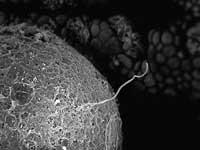Return to overcome the obstacles of human cloning

Human cloning for reproduction has many obstacles. From the ethical point of view, most do not accept the idea of creating a being with the same genetic information as someone, who in principle seems totally rejectable and sees no reason to justify human cloning. In addition, the law does not allow investigations that are carried out with the aim of creating a human being by cloning.
However, the limits and obstacles of human cloning for reproduction are not only ethical and legal: the cloning technique itself still presents serious drawbacks. The most used technique is nuclear transfer, which consists of the capture of a cell of the being that is wanted to clone, the extraction of the nucleus and its placement in an egg, to which its nucleus has been removed. By concentrating the genetic information of the being in the nucleus, the egg that has replaced it contains genetic information from the other cell.
After the excitation of this oculus, the unfolding begins and moves to the embryo phase, where the embryo develops completely in a uterus and ends up being born a clonic being. All this in theory. In fact, things are not so easy.
A vulgar zygote, a newly fertilized egg, collects in the nucleus the genetic information of the egg and sperm. Within this, it is written which genes must be activated and disable to begin to develop the embryo and depending on this, the zygote is divided to give the embryo.
Key in reprogramming
However, when the nucleus of the egg is replaced, genetic information belongs to an adult cell from which the embryo must be ‘rejuvenated’. This is what is known as reprogramming, a process that allows the cell to provide the necessary characteristics to initiate the development of the embryo.

However, scientists do not know sufficiently well the process of reprogramming and believe that errors occur. Precisely to these errors are attributed the guilt that the degree of success of the cloning is so low. In fact, many of the clones born are lost along the way, and those who live also suffer from serious health problems. For example, the famous sheep Dolly lost 277 clonic lambs at birth and Dolly himself suffered the symptoms of aging prematurely. It is understandable, therefore, that such experiments are prohibited in the human being, since the minimum requirements of viability are not met.
A round to solve the problem
Precisely, in the congress of the Human Genome Organization a solution to this problem has been presented: the researchers of the Whitehead Institute of Cambridge of the US have proposed to use the ovules and sperm instead of allowing the advancement of the cloned embryo. Why? Because in the process of creating eggs and sperm the reprogramming is spontaneous. And in that natural process, errors that have previously occurred are thought to be eliminated.
From there, the path is not very difficult: there is only one in vitro fertilisation with the egg or sperm obtained from the clonic embryo. It is a known and safe technique that considerably increases the chances of getting a healthy child. In addition, they consider that the ethical drawbacks of some will also be overcome, since the child that occurs is not a clone, since, as in normal fertilization, it has genetic information of two.
However, they still do not have it all clear. Obtaining eggs and sperm from the embryo is based on a fundamental characteristic of the cells of the initial embryo. These cells are called stem cells and they are all powerful, that is, they have the capacity to transform them into any type of cell and, therefore, in eggs and sperm. However, they still do not know what signs stem cells need to become ovules and sperm cells.
Hopeful surprise

Shortly after submitting this proposal, they published in Science a work from the University of Pennsylvania (USA). According to this article, it may not be as difficult to get eggs from stem cells as believed.
In this study they have shown that stem cells of the embryos of the mice can become, by themselves, eggs without external factors. In fact, the researchers had stem cells of mice in a breeding medium in which they have identified the eggs. As they have explained, the process is really simple, it occurs spontaneously, it is about detecting these eggs. For this purpose they have used a fluorescent marker.
Yes, researchers recognize that they do not know if those eggs identified are normal or not, if they can be fertilized or if the drunks developed by them could be viable. However, it seems that in reproductive cloning, a rendija has been opened.





